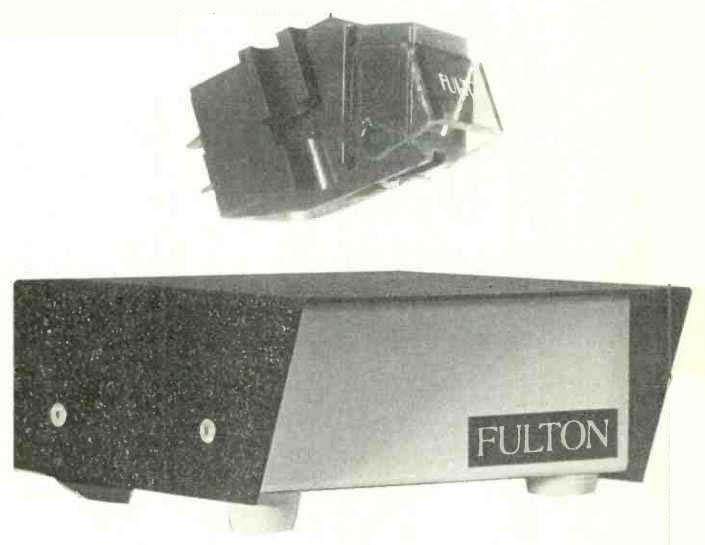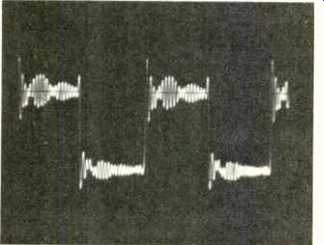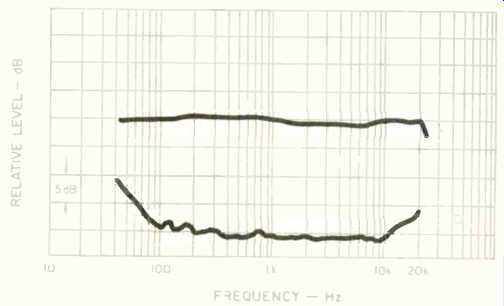
Fulton MC-1 Moving-Coil Transformer
Manufacturer's Specifications:
Input Impedance: 3 to 4 ohms.
Frequency Response: 5 hz to 65 kHz.
Gain: 28 dB.
Price: $289.00.
Fulton RS-1 Moving-Coil Phono Cartridge
Manufacturer's Specifications:
Frequency Response: 10 Hz to 60 kHz, +0,-.5 dB.
Channel Separation at 1 kHz: 34 dB.
Channel Separation at 10 kHz: 30 dB.
Output Voltage: 0.33 mV at 1 kHz.
Impedance: 4 ohms.
Recommended Transformer Impedance: 3 to 4 ohms.
Recommended Load Capacitance: 30 pF.
Recommended Pre-Preamp Load: 125 ohms minimum.
Stylus Type: Conical.
Stylus Radius: 0.65 mils.
Stylus Compliance: 12 x 10^-6cm.
Tracking Force: 1.5 to 1.75 grams.
Vertical Tracking Angle: 20°.
Weight: 5 grams.
Price: $350.00.
Fulton Musical Industries (FMI), manufacturers of the Fulton Premier loudspeakers, have introduced a high performance miniature transducer to their line--the Fulton RS-1 moving-coil phono cartridge with matching transformer. In general, it is not unlike other moving-coil cartridges except that its stylus has a spherical (conical) tip.
The stylus is a nude diamond with a square shank and a spherical tip having a radius of 0.65 mils. Fulton elected to use a spherical tip because they believe that both elliptical and Shibata shape styli are subject to forces that twist them as they pass over modulated groove walls. Further, this twisting motion of the stylus is transmitted down the cantilever and is reproduced as distortion by the phono cartridge.
There is much less extraneous torquing of the cantilever by its stylus with a conical tip: At 5 kHz, Fulton engineers have measured three times the distortion with elliptical and Shibata styli than with a conical. Accordingly, the tendency of an elliptical or Shibata stylus to twist or torque indicates that the nuances of music are lost and, at the same time, distortion in the critical 2- to 9-kHz frequency range is added. A conical tip apparently sidesteps this problem.
While there are certain theoretical advantages to the elliptical or Shibata shapes, Fulton engineers believe that those advantages are seldom realized in the conventional phono playback system. Both elliptical and Shibata designs assume a perfect tangential-tracking tonearm to constantly keep the cantilever at right angles to the radius of the record groove. However, since most tonearms are pivoted, they have only two points where the cantilever is perfectly tangent to the record groove. On all other points across the record, the cantilever will labor with as much as two degrees of tracking error imparted by the tonearm. Lateral tracking error plays havoc with an elliptical or Shibata stylus due to its shape, but is never much of a problem with spherical-shaped styli, according to Fulton.
It is claimed that a modern spherical design, with lighter tracking and higher compliance, does not have a problem with record wear. In fact, Fulton claims that a 0.65-mil spherical tip provides some of the same advantages as a 0.3 x 0.7-mil elliptical stylus. The stylus assembly is not user-replaceable, but must be returned to the manufacturer or dealer for replacement, as with many moving coils.
Measurements
I mounted the Fulton moving-coil cartridge in a Technics headshell on the Technics EPA-100 tonearm on a Technics SP-10 Mk II turntable. Voltage step-up for the cartridge was provided by a Fulton moving-coil cartridge transformer.
Wherever necessary, I made measurements using this transformer; its measured frequency response was +0, -1.5 dB from 48 Hz to 20 Hz. The measured gain of the transformer was 28.3, and the square wave rise time at 1 kHz was 9uS. The cartridge was oriented in the headshell and tonearm with the Dennesen Geometric Soundtracktor. Laboratory tests were conducted at an ambient temperature of 76°F ± 1° (24.4°C) and a relative humidity of 58% ±3%. The tracking force for all reported tests was at the optimum force of 1.6 grams, with an anti-skating force of 1.85 grams. As is my practice, measurements are made on both channels, but only the left is reported unless there is a significant difference between the two channels.
Frequency response, using the CBS STR-170 test record, is flat within-0.5, + 1 dB from 40 Hz to 20 kHz. Separation is 22 dB at 1 kHz, 23.5 dB at 8 kHz, 22.5 dB at 10 kHz, 18.6 dB at 15 kHz, and dB at 20 kHz. From these data, it is evident that the Fulton cartridge has an excellent frequency response and a most satisfactory high-frequency separation for a well-defined stereo effect on playback. We might comment that the separation for the right channel was slightly less than that for the left channel.
The 1-kHz square wave is typical for most moving-coil cartridges, showing ultrasonic ringing indicative of is wide bandwidth which can reproduce the 43-kHz cutter resonance on the test record. The cartridge-arm low-frequency lateral resonance was at 9.4 Hz and of 4.8 dB amplitude with the Technics EPA-100 tonearm. The vertical resonance was about 12 Hz in the same arm.
The following test records were used in making the reported measurements: Shure TTR-103, TTR-109, TTR-110, and TTR-115; Columbia STR-170, STR-100, and STR-112; Deutsches Hi-Fi No. 2; Nippon Columbia Audio Technical Record (PCM) XG-7002, and Ortofon Direct-Cut Pickup Test Record 0001.
Wt., 5.1 g; opt. tracking force, 1.6 g; anti-skating force, 1.85 g; output (without transformer), 0.048 µV/cm/S; output (with transformer), 1.21 mV/cm/S; IM distortion (4:1) +9 dB lateral, 200/4000 Hz, 0.65%; +6 dB vertical, 200/4000 Hz, 4.6%; crosstalk (using Shure TTR-109), 24.5 dB; channel balance, 0.5 dB; trackability: high freq. (10.8 kHz pulsed), 30 cm/S, mid-freq. (1 kHz + 1.5 kHz, lat. cut), 31.5 cm/S, low freq. (400 + 4000 Hz, lat. cut), 24 cm/S; Deutsches Hi Fi No.2 300-Hz test band was tracked cleanly to 77 microns (0.0077 cm) lateral at 14.5 cm/S at +8.7 dB and 55.4 microns (0.00554 cm) vertical at 10.32 cm/S at +5.86 dB. The latter measurements are relatively good, especially the vertical one. Few cartridges can track the higher velocity 300-Hz bands on this test record.
The Shure Obstacle Course-Era III test record offered no challenge to the Fulton cartridge. On the Shure Obstacle Course-Era IV test record, the cartridge passed all test bands except for the level-5 harp and harp-and-flute test bands, where just a hint of mistracking was heard.

Fig. 1--Response to a 1-kHz tone burst.

Fig. 2--Frequency response and separation.
Use and Listening Tests
The following equipment was utilized in the listening evaluation of the Fulton moving-coil phono cartridge: Technics SP-10 Mk II turntable, Technics EPA-100 tonearm, Nikko Beta 1 preamplifier, Crown IC-150 preamplifier, Audionics Space and Image Composer, Audire DM-700 power amplifier, Audio Innovation LED 2C Dynamic Power Display, and a pair of stacked Duntech DL-15B speakers in each channel. Each pair of speakers was connected to the Audire DM: 700 power amplifier with Monster Cable. The turntable was equipped with the Hiraoka Disk-SE22 turntable mat.
As usual, I performed listening tests both before and after measurement. During this period, I was particularly impressed with the cartridge's ability to track extremely warped records without affecting reproduced sonic quality.
Without a doubt, the Fulton moving-coil cartridge acquitted itself very well, especially in superb transient response (including percussion transient response), excellent applause definition, sonic clarity, and transparency of sound. The bass was sonically well-defined and tight, with a good reproduction of the 19.2-Hz organ pedal note. The Fulton cartridge introduced no apparent coloration nor audible distortion to the music being played. The human voice was reproduced particularly well, especially the male voices.
All in all, the Fulton moving-coil cartridge should be considered as an excellent choice for anyone desiring a top-notch moving-coil phono cartridge.
-B. V. Pisha
(Source: Audio magazine, Sept. 1982)
Also see:
Grado XTE + 1, SIGNATURE 8MX, and SIGNATURE MCX phono cartridges (June 1987)
Monster Cable Alpha 1 Cartridge (Jan. 1984)
= = = =